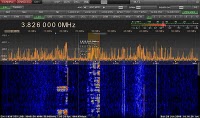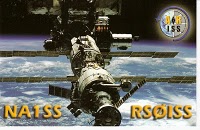 Amateur radio, often called ham radio, is both a hobby and a service in which participants, called "hams", use various types of radio communications equipment to communicate with other radio amateurs for public services, recreation and self-training. Amateur radio operation is licensed by an appropriate government entity (for example, by the Federal Communications Commission in the United States or by the Ministry of Infrastructure, Transport and Networks in Greece) as coordinated through the International Telecommunication Union. An estimated two million people throughout the world are regularly involved with amateur radio. The term "amateur" does not imply a lack of skill or quality, but rather that amateur radio and its operators work outside of an official, governmental or commercial capacity.
Amateur radio, often called ham radio, is both a hobby and a service in which participants, called "hams", use various types of radio communications equipment to communicate with other radio amateurs for public services, recreation and self-training. Amateur radio operation is licensed by an appropriate government entity (for example, by the Federal Communications Commission in the United States or by the Ministry of Infrastructure, Transport and Networks in Greece) as coordinated through the International Telecommunication Union. An estimated two million people throughout the world are regularly involved with amateur radio. The term "amateur" does not imply a lack of skill or quality, but rather that amateur radio and its operators work outside of an official, governmental or commercial capacity.
Although its origins can be traced to at least the late 1800s, amateur radio, as practiced today, did not begin until the early 1900s. The first listing of amateur radio stations is contained in the First Annual Official Wireless Blue Book of the Wireless Association of America in 1909. This first radio callbook lists wireless telegraph stations in Canada and the United States, including eighty-nine amateur radio stations. As with radio in general, the birth of amateur radio was strongly associated with various amateur experimenters and hobbyists. Throughout its history, amateur radio enthusiasts have made significant contributions to science, engineering, industry, and social services. Research by amateur radio operators has founded new industries, built economies, empowered nations, and saved lives in times of emergency. Amateur radio operators use various modes of transmission to communicate. Voice transmissions are most common, with some, such as frequency modulation (FM) offering high quality audio, and others, such as single sideband (SSB) offering more reliable communications, often over long distance, when signals are marginal and bandwidth is restricted, at the sacrifice of audio quality. Radiotelegraphy using Morse code (also known as "CW" from "continuous wave") is an activity dating to the earliest days of radio. It is the wireless extension of land line (wire based) telegraphy developed by Samuel Morse and was the predominant real time long-distance communication method of the 19th century. Though computer-based (digital) modes and methods have largely replaced CW for commercial and military applications, many amateur radio operators still enjoy using the CW mode, particularly on the shortwave bands and for experimental work such as earth-moon-earth communication, with its inherent signal-to-noise ratio advantages. Morse, using internationally agreed message encodings such as the Q code, enables communication between amateurs who speak different languages. It is also popular with homebrewers as CW-only transmitters are simpler to construct. A similar "legacy" mode popular with home constructors is amplitude modulation (AM), pursued by many vintage amateur radio enthusiasts and aficionados of vacuum tube technology.
Amateur radio operators use various modes of transmission to communicate. Voice transmissions are most common, with some, such as frequency modulation (FM) offering high quality audio, and others, such as single sideband (SSB) offering more reliable communications, often over long distance, when signals are marginal and bandwidth is restricted, at the sacrifice of audio quality. Radiotelegraphy using Morse code (also known as "CW" from "continuous wave") is an activity dating to the earliest days of radio. It is the wireless extension of land line (wire based) telegraphy developed by Samuel Morse and was the predominant real time long-distance communication method of the 19th century. Though computer-based (digital) modes and methods have largely replaced CW for commercial and military applications, many amateur radio operators still enjoy using the CW mode, particularly on the shortwave bands and for experimental work such as earth-moon-earth communication, with its inherent signal-to-noise ratio advantages. Morse, using internationally agreed message encodings such as the Q code, enables communication between amateurs who speak different languages. It is also popular with homebrewers as CW-only transmitters are simpler to construct. A similar "legacy" mode popular with home constructors is amplitude modulation (AM), pursued by many vintage amateur radio enthusiasts and aficionados of vacuum tube technology.
For many years, demonstrating a proficiency in Morse code was a requirement to obtain amateur licenses for the high frequency bands (frequencies below 30 MHz), but following changes in international regulations in 2003, many countries are no longer required to demand proficiency.
 Modern personal computers have encouraged the use of digital modes such as radioteletype (RTTY), which previously required cumbersome mechanical equipment. Hams led the development of packet radio in the 1970s, which has employed protocols such as TCP/IP since the 1980s. Specialized digital modes such as PSK31 allow real-time, low-power communications on the shortwave bands. Echolink using Voice over IP technology has enabled amateurs to communicate through local Internet-connected repeaters and radio nodes, while IRLP has allowed the linking of repeaters to provide greater coverage area. Automatic link establishment (ALE) has enabled continuous amateur radio networks to operate on the high frequency bands with global coverage. Other modes, such as FSK441 using software such as WSJT, are used for weak signal modes including meteor scatter and moonbounce communications.
Modern personal computers have encouraged the use of digital modes such as radioteletype (RTTY), which previously required cumbersome mechanical equipment. Hams led the development of packet radio in the 1970s, which has employed protocols such as TCP/IP since the 1980s. Specialized digital modes such as PSK31 allow real-time, low-power communications on the shortwave bands. Echolink using Voice over IP technology has enabled amateurs to communicate through local Internet-connected repeaters and radio nodes, while IRLP has allowed the linking of repeaters to provide greater coverage area. Automatic link establishment (ALE) has enabled continuous amateur radio networks to operate on the high frequency bands with global coverage. Other modes, such as FSK441 using software such as WSJT, are used for weak signal modes including meteor scatter and moonbounce communications.
Fast scan amateur television has gained popularity as hobbyists adapt inexpensive consumer video electronics like camcorders and video cards in PCs. Because of the wide bandwidth and stable signals required, amateur television is typically found in the 70 cm (420 MHz–450 MHz) frequency range, though there is also limited use on 33 cm (902 MHz–928 MHz), 23 cm (1240 MHz–1300 MHz) and higher. These requirements also effectively limit the signal range to between 30 km–100 km, however, the use of linked repeater systems can allow transmissions across hundreds of kms.
These repeaters, or automated relay stations, are used on VHF and higher frequencies to increase signal range. Repeaters are usually located on top of a mountain, hill or tall building, and allow operators to communicate over hundreds of square miles using a low power hand-held transceiver. Repeaters can also be linked together by use of other amateur radio bands, landline or the Internet. Communication satellites called OSCARs (Orbiting Satellite Carrying Amateur Radio) can be accessed, some using a hand-held transceiver (HT), even, at times, using the factory "rubber duck" antenna. Hams also use the moon, the aurora borealis, and the ionized trails of meteors as reflectors of radio waves. Hams are also often able to make contact with the International Space Station (ISS), as many astronauts and cosmonauts are licensed as amateur radio operators.
Communication satellites called OSCARs (Orbiting Satellite Carrying Amateur Radio) can be accessed, some using a hand-held transceiver (HT), even, at times, using the factory "rubber duck" antenna. Hams also use the moon, the aurora borealis, and the ionized trails of meteors as reflectors of radio waves. Hams are also often able to make contact with the International Space Station (ISS), as many astronauts and cosmonauts are licensed as amateur radio operators.
Amateur radio operators use their amateur radio station to make contacts with individual hams as well as participating in round table discussion groups or "rag chew sessions" on the air. Some join in regularly scheduled on-air meetings with other amateur radio operators, called "nets" (as in "networks") which are moderated by a station referred to as "Net Control". Nets can allow operators to learn procedures for emergencies, be an informal round table or be topical, covering specific interests shared by a group
Upon licensing, a radio amateur's national government issues a unique call sign to the radio amateur. The holder of a call sign uses it on the air to legally identify the operator or station during any and all radio communication. Call sign structure as prescribed by the ITU, consists of three parts which break down as follows, using the call sign SV8GXC as an example:
SV – Shows the country from which the call sign originates and may also indicate the license class. (This call sign is licensed in Greece, and is CEPT Class 1).
8 – Gives the subdivision of the country or territory indicated in the first part (this one refers to the Aegean Islands).
GXC – The final part is unique to the holder of the license, identifying that person specifically.
Reference:
[1] Wikipedia, Amateur radio, http://en.wikipedia.org/wiki/Amateur_radio
Thursday, September 2, 2010
What is Ham Radio
Labels:
ham radio theory